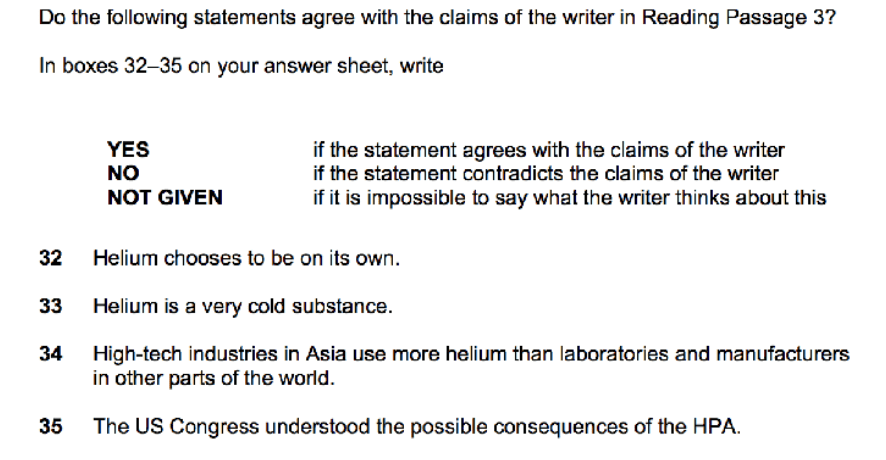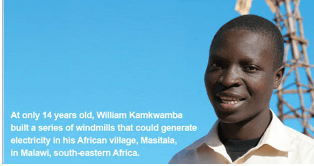Luyện tập dạng bài True/False/Notgiven trong IELTS Reading với các bước làm bài hiệu quả nhé!
1. Kiến thức TRUE/FALSE/NOT GIVEN
Đây là dạng bài dễ sai trong bài thi IELTS Reading, và dễ nhầm lẫn giữa các đáp án.
Tips đó là các bạn hãy luyện thật nhiều dạng bài này trong cuốn Cam để “thấm nhuần tư tưởng” ra đề và cách chọn đáp án của tác giả, như vậy khi làm bài thi thật thì cảm giác đánh đáp án sẽ chắc tay hơn. Biết chắc câu này là True/ False hay Not Given. Vì không phải mình đọc vào thấy không hợp lý là chọn, phải dựa vào bài đọc, dựa vào thói quen ra đề của IELTS Reading.
Luyện tập thật nhiều sẽ không còn sai nữa, vì mình biết chắc chắn có rất nhiều bạn sợ dạng bài này mà đúng không.
Lát nữa bên dưới mình sẽ nói sâu hơn nhé, nhìn sơ qua để nhận biết dạng bài nè:

2. Các bước làm bài
Bước 1: Xác định T/F/NG hay Y/N/NG
Đầu tiên hãy xác định đó là TRUE /FALSE /NOT GIVEN hay YES /NO /NOT GIVEN, vì nếu đề bài là TRUE /FALSE /NOT GIVEN mà bên dưới các bạn đánh YES /NO /NOT GIVEN thì SẼ KHÔNG ĐƯỢC TÍNH ĐIỂM, cho nên là phải cực kỳ cẩn thận, vì mình cũng bị nhầm rất nhiều lần cho nên thường mình sẽ khoanh tròn, đóng khung đề bài trước khi làm.
Tiếp theo, quy tắc của Reading đó là luôn luôn đọc câu hỏi trước khi đọc bài đọc (quy tắc của tùy người nhé, miễn sao bạn thấy hiệu quả), mình luôn đọc câu hỏi trước và gạch chân những keywords.
Ví dụ:
Your Rider Indentify Card will be sent to you before the event.
Gạch chân keyword: Rider Indentify Card (vì cụm này được ghi in hoa nên sẽ dễ spot trong bài đọc); before (vì nếu trong bài đọc nói “after” thì đây là False, bài đọc không đề cập về thời gian “trước” hay “sau” thì đây là NOT GIVEN”)
Xem Thêm: Sharpen Your Short Answer Trong IELTS Reading
Sharpen your IELTS Reading Skill Matching Features
Sharpen your Multiple Choice Trong IELTS Reading Skill
Bước 2: Đọc bài đọc và chọn lọc đáp án
Hãy nhớ rằng True/False/Notgiven sẽ đi theo thứ tự câu hỏi tương ứng với thứ tự bài đọc. Cho nên là thường mình sẽ đọc 1 lúc 2 câu hỏi luôn rồi mới tìm vị trí của câu đó trong bài đọc. Vì sợ trường hợp câu đầu tiên là Not Given thì có tìm mãi cũng ko ra vị trí. Nên để làm bài nhanh hơn các bạn có thể gom combo 2-3 câu lại, nhớ keywords rồi tìm nhé.
Tìm thấy vị trí thông tin nằm ở đâu rồi thì giờ chỉ cần đọc kỹ lại thôi, đọc thật kỹ nhé, và tất cả mọi thứ đều chỉ trong giới hạn bài đọc thôi.
Quy tắc vàng: TUYỆT ĐỐI KHÔNG SUY DIỄN. Suy diễn một hồi chắc chắn sẽ sai, tin mình đi Nên chỉ đọc thông tin trong bài đọc, và xác định thôi, đừng nghĩ quá phức tạp, đừng suy diễn, đừng nghĩ theo ý của mình, hãy nên nhớ rằng tác giả viết cũng không quá đánh đố bạn 1 cách phức tạp hóa đâu, hãy đơn giản hóa mọi thứ và biết tác giả “lừa” mình ở đâu, từ đó chọn theo lý trí và sự chắc chắn.
Một quy tắc nữa là tuyệt đối không nhầm False và Not given, nếu không đề cập là Not Given, hoặc có một vế không đề cập cũng là Not Given.
Nếu trái ngược hoàn toàn là False, hoặc trong bài đọc nói là “Bộ phận Sales là bộ phận cần nhân sự nhiều nhất công ty….”. Câu hỏi là “Vì tính chất của công ty nên cần rất nhiều nhân sự, có nói là nhiều nhất, làm trong bộ phận Marketing ” thì câu này sẽ là T/F hay NG? Đáp án là “False”, vì bộ phận nhiều nhân sự nhất chỉ có 1 bộ phận, là đó là bộ phận Marketing chứ không phải Sales. Cho nên câu này là FALSE.
Bước 4: Kiểm tra đáp án
Kiểm tra nhanh đáp án thường mình sẽ nhìn bằng mắt, tức là ví dụ có 5 câu, mà mình chọn TRUE TRUE TRUE TRUE FALSE, là thấy hơi sai sai rồi đó. Thứ nhất là chưa thấy Not given (mà đáng lẽ thông thường bài thi sẽ xuất hiện đủ cả 3 lựa chọn T/F/NG), thứ 2 là có 4 câu True liên tiếp (khá hiếm nhỉ) nên chắc chắn 1 trong 4 đó có khả năng cao là sai cần được check lại.
Nhưng check kỹ thì cần phải check lại từng câu nhé, thông thường câu nào không chắc mình sẽ khoanh tròn lại, lát nữa cuối giờ còn dư thời gian sẽ kiểm tra lại, như vậy kiểm tra 2-3 lần sẽ chắc ăn hơn.
Free Test and Practice with IELTS.TOOLS
3. Luyện tập – True/False/Notgiven Trong IELTS Reading
William Kamkwamba

In 2002, William Kamkwamba had to drop out of school, as his father, a maize and tobacco farmer, could no longer afford his school fees. But despite this setback, William was determined to get his education. He began visiting a local library that had just opened in his old primary school, where he discovered a tattered science book. With only a rudimentary grasp of English, he taught himself basic physics – mainly by studying photos and diagrams. Another book he found there featured windmills on the cover and inspired him to try and build his own.
He started by constructing a small model. Then, with the help of a cousin and friend, he spent many weeks searching scrap yards and found old tractor fans, shock absorbers, plastic pipe and bicycle parts, which he used to build the real thing.
For windmill blades, William cut some bath pipe in two lengthwise, then heated the pieces over hot coals to press the curled edges flat. To bore holes into the blades, he stuck a nail through half a corncob, heated the metal red and twisted it through the blades. It took three hours to repeatedly heat the nail and bore the holes. He attached the blades to a tractor fan using proper nuts and bolts and then to the back axle of a bicycle. Electricity was generated through the bicycle dynamo. When the wind blew the blades, the bike chain spun the bike wheel, which charged the dynamo and sent a current through wire to his house.
What he had built was a crude machine that produced 12 volts and powered four lights. When it was all done, the windmill’s wingspan measured more than eight feet and sat on top of a rickety tower 15 feet tall that swayed violently in strong gales. He eventually replaced the tower with a sturdier one that stands 39 feet, and built a second machine that watered a family garden.
The windmill brought William Kamkwamba instant local fame, but despite his accomplishment, he was still unable to return to school.
However, news of his magetsi a mphepo – electric wind – spread beyond Malawi, and eventually things began to change. An education official, who had heard news of the windmill, came to visit his village and was amazed to learn that William had been out of school for five years. He arranged for him to attend secondary school at the government’s expense and brought journalists to the farm to see the windmill. Then a story published in the Malawi Daily Mail caught the attention of bloggers, which in turn caught the attention of organisers for the Technology Entertainment and Design conference.
In 2007, William spoke at the TED Global conference in Tanzania and got a standing ovation. Businessmen stepped forward with offers to fund his education and projects, and with money donated by them, he was able to put his cousin and several friends back into school and pay for some medical needs of his family. With the donation, he also drilled a borehole for a well and water pump in his village and installed drip irrigation in his father’s fields.
The water pump has allowed his family to expand its crops. They have abandoned tobacco and now grow maize, beans, soybeans, potatoes and peanuts. The windmills have also brought big lifestyle and health changes to the other villagers. ‘The village has changed a lot,’ William says. ‘Now, the time that they would have spent going to fetch water, they are using for doing other things. And also the water they are drinking is clean water, so there is less disease.’ The villagers have also stopped using kerosene and can use the money previously spent on fuel to buy other things.
William Kamkwamba’s example has inspired other children in the village to pursue science. William says they now see that if they put their mind to something, they can achieve it. ‘It has changed the way people think,’ he says.
Questions 6-10
Do the following statements agree with the information given in Reading Passage?
In boxes 6-10 on your answer sheet write
TRUE – if the statement agrees with the information
FALSE – if the statement contradicts the information
NOT GIVEN – if there is no information on this
6. William used the electricity he created for village transport. ……….
7. At first, William’s achievement was ignored by local people. ……….
8. Journalists from other countries visited William’s farm. ……….
9. William used money he received to improve water supplies in his village. ……….
10. The health of the villagers has improved since the windmill was built. ……….
KEY
6. FALSE
7. FALSE
8. NOT GIVEN
9. TRUE
10. TRUE

